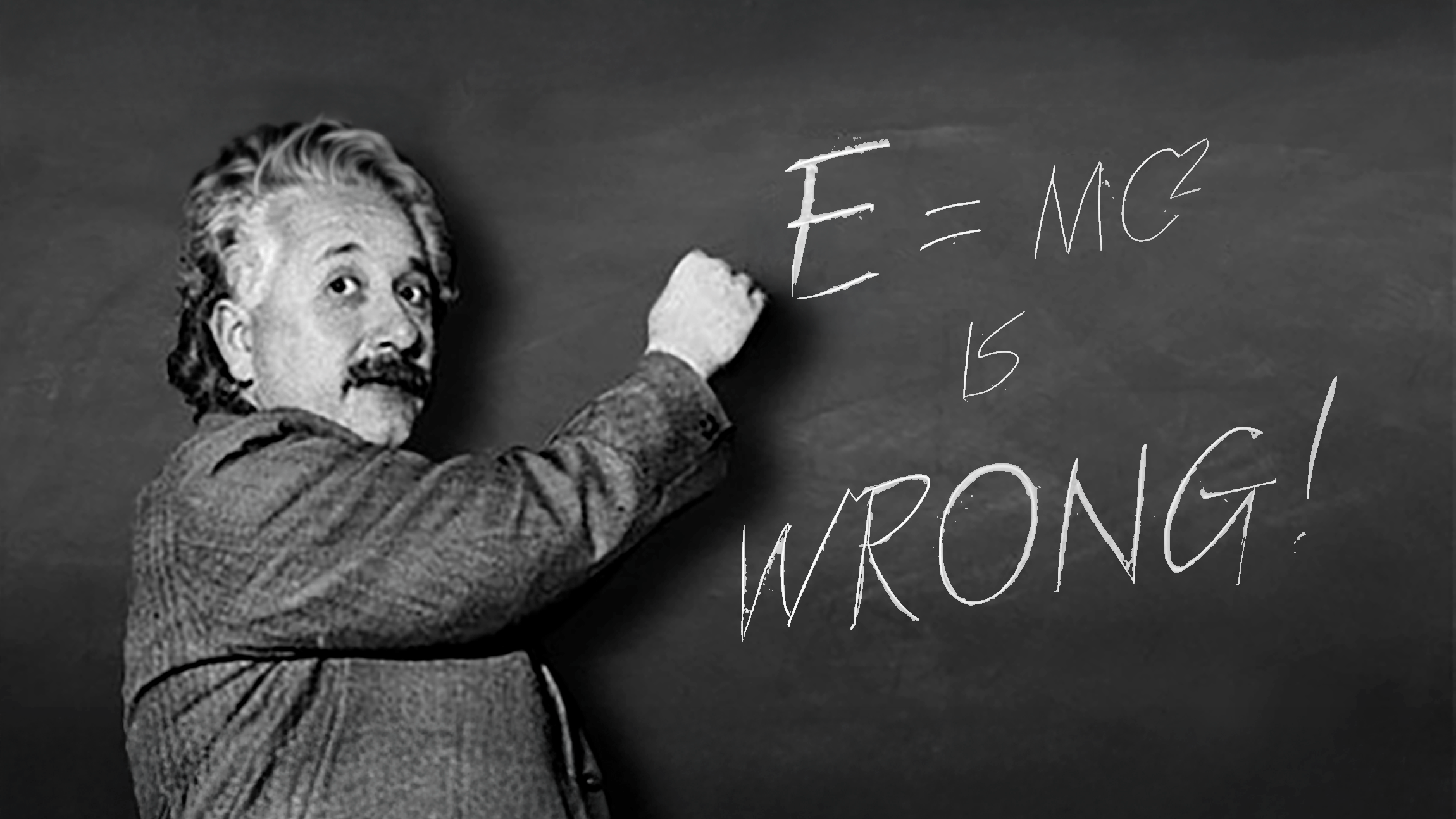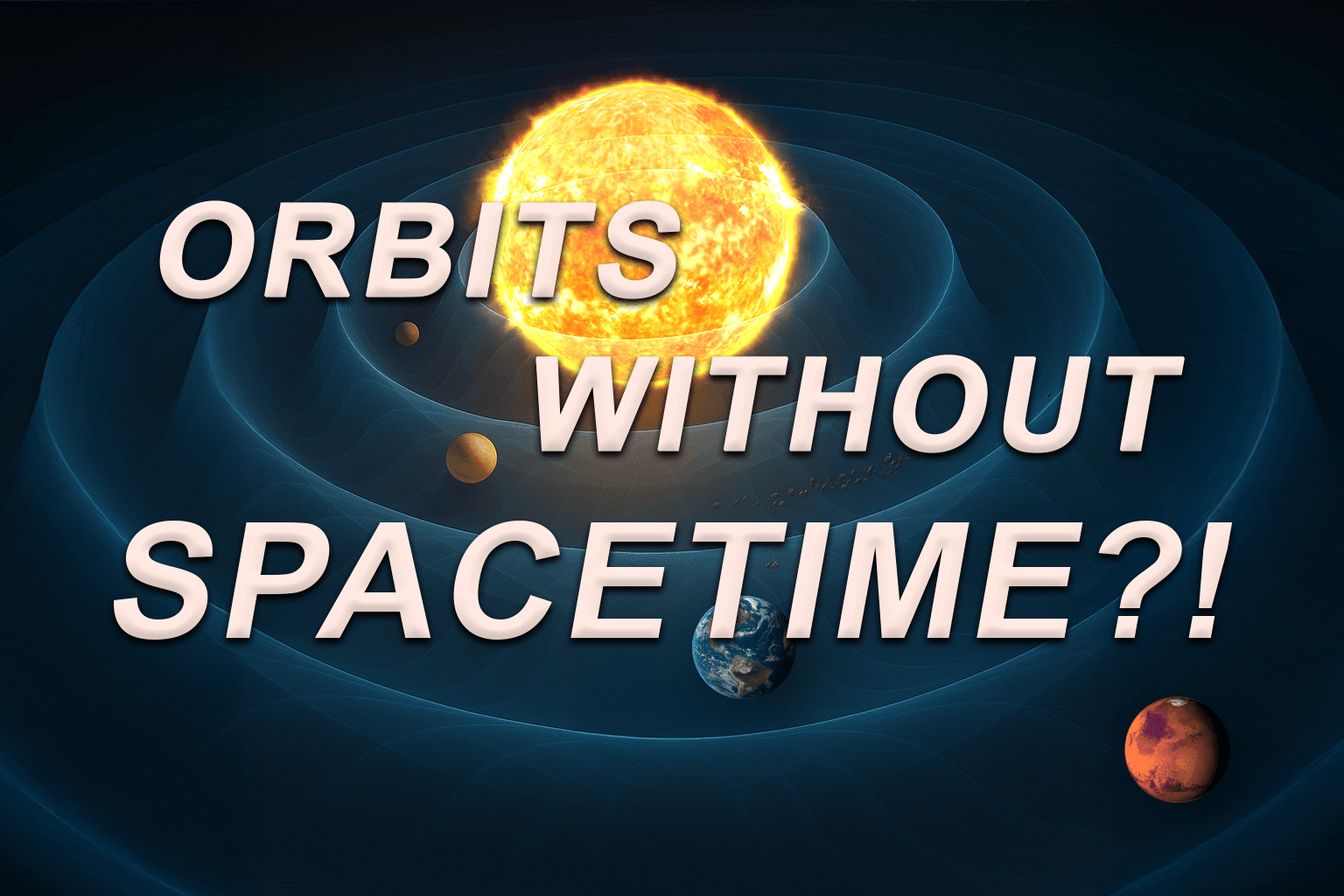Why Einstein’s Famous Equation, E = mc², Has Misdirected Physics—and How Wave Mechanics Explains What Relativity Cannot
The Cult of the Equation
For over a century, E = mc² has dominated physics classrooms, textbooks, museums, and documentaries. It’s recited with near-religious reverence as the equation that changed everything. But this cult status is built not on causal clarity, but on abstraction. Despite its ubiquity, the equation offers no mechanism, no explanation of how mass becomes energy, or how energy possesses inertia. It’s a shell—elegant in form but hollow in substance. This isn’t a challenge to the arithmetic of Einstein’s famous formula. It’s a declaration that the equation explains nothing and has stalled physics from progressing into the mechanical reality of the universe.
Acoustic Gravitic Theory (AGT) provides an entirely different picture. It dismantles the equation’s central premise by grounding gravity, energy, and motion in the behavior of real waves within real media. AGT doesn’t treat mass as a mysterious energy reservoir waiting to be unlocked. It treats mass as an impedance effect—a mechanical resistance to phase-synchronous motion within a structured wave field. This framing reframes the entire energy paradigm of physics.
Spacetime Is a Mirage
At the heart of E = mc² lies a deeper assumption: that space is empty, and that mass curves this nothingness into gravitational wells. General Relativity gave us spacetime, a four-dimensional manifold with no density, viscosity, or mechanical properties. It is an idealized mathematical abstraction masquerading as the fabric of reality. But empirical science has advanced far beyond these postulates. Satellite missions such as Parker Solar Probe and Voyager have made it abundantly clear that space is not a void. It is a plasma-filled, wave-active, electrically conductive medium teeming with structure. This medium supports Langmuir oscillations, Alfvén waves, magnetosonic fronts, and long-range field-aligned Birkeland currents. It possesses impedance, supports standing waves, and transmits directional energy—none of which spacetime curvature can account for.
AGT restores the medium to its rightful place. It defines the universe not as a coordinate grid waiting to be deformed by mass, but as a dynamic sea of oscillating fields and wave structures. It rejects the vacuum model not as a scientific refinement, but as a fundamental error that replaced causality with geometry. If there is no physical medium, there can be no transmission of force. If there is no impedance, there can be no interaction. And if mass has no context in a medium, then energy has no mechanism.
Mass Is a Reaction, Not a Container
E = mc² implies mass holds energy, like a battery holds charge. But this concept never provides a mechanism. Where does this energy reside? How is it stored? What triggers its release? No answer is given—only a number. AGT discards this mysticism and replaces it with an observable, causal process. Under AGT, mass is not a substance. It is a symptom. Specifically, it is the physical expression of impedance mismatch between an object and the surrounding wave field in which it is immersed.
When an object fails to oscillate in phase with a surrounding field—whether infrasonic pressure waves in Earth’s atmosphere or plasma oscillations in space—it accumulates pressure differentials. These build across its boundaries asymmetrically. This asymmetry results in a net directional force known in classical fluid mechanics as the Primary Bjerknes Force. This force is not hypothetical. It is measurable, reproducible, and well understood. AGT scales this force up and applies it not to bubbles in a tank—but to buildings, mountains, satellites, and planets.
This means weight is not the result of attraction from a distant mass. It is the result of compression by a structured wave field. Mass, in this interpretation, becomes a resistance coefficient. It is not a source of energy. It is not a container of potential. It is an emergent property that describes how well or poorly an object synchronizes with the rhythm of the medium that surrounds it.
Energy Is Not Stored in Mass—It’s Propagated by Waves
In the AGT framework, energy is not something that resides inside mass. It is a pressure-based condition that exists between interacting systems. It is defined by amplitude, frequency, medium structure, and phase response—not by intrinsic content. Wave energy is transferred, not contained. That means what we’ve called “mass-energy equivalence” is a misreading. Energy is not hidden inside a rock waiting to be unlocked by c². Instead, energy is pressure traversing a medium. It exists only in relation to wave structure, not as a latent mass reservoir.
AGT reinterprets the velocity term in E = mc², which traditionally refers to the speed of light squared, as a misleading overreach. The speed of light should not be a cosmic speed limit derived from vacuum curvature. Instead, it is one of many velocity profiles for wave transmission within plasma, dependent on field strength, density, and impedance. In a medium-based cosmology, velocities change with conditions. They are not fixed absolutes, but contextual limits.
Therefore, the c² in Einstein’s equation does not unlock anything. It does not convert mass into energy. It is merely the square of a speed assigned to a wave mode that itself is variable, depending on the structure of the plasma through which it moves.
Experiments That Undermine Einstein’s Legacy
If mass is just an impedance reaction to wave fields, and gravity is just structured pressure gradients, then these principles can be tested. AGT proposes three core experiments. First, synchronized gravimeter and infrasound measurements during coronal mass ejections (CMEs) would reveal a direct correlation between solar-induced ELF/ULF wave activity and fluctuations in local gravitational pressure. These microgravity deviations, even if only 10–30 μGal, would represent real-time modulation of gravity by oscillatory wave input.
Second, harmonic simulations of solar oscillations in a plasma cavity would show that planets do not need curved spacetime to orbit. They would instead lock into standing wave nodes as a function of impedance alignment. Phase-locking would produce harmonic distances that match observed planetary orbits. Orbital positioning would emerge from resonance, not velocity balancing against geometric curvature.
Third, a phase-cancellation experiment in which a precisely tuned 180° phase-inverted infrasonic wave is emitted toward a suspended object. This object, subject to atmospheric pressure gradients, is expected to show a measurable weight reduction of 5% when exposed to destructive wave interference. This would empirically demonstrate that downward force is a pressure condition, not a result of mass-attraction—again, confirming AGT’s model and refuting the idea that gravity is a static mass-derived force.
Relativity’s Greatest Claims—All Mechanically Explained by AGT
Gravitational lensing is often cited as the crown jewel of Einstein’s success. Light, it is said, bends around stars due to spacetime curvature. But plasma physics offers a better explanation: light refracts through the Sun’s corona due to differences in electron density and permittivity. This is textbook wave behavior, observable in any dielectric gradient. The plasma refractive index, as derived from Maxwell’s equations in a dispersive medium, is
where fp is the plasma frequency determined by local electron density. This shows that even extremely small density gradients—such as those found in the Sun’s corona—can refract light, producing angular deflections equivalent to those predicted by general relativity.
In this context, gravitational lensing is not a result of spacetime curvature, but a classical wave phenomenon governed by electromagnetic field interactions within plasma. The bending of light is not mysterious—it is the predictable result of wave propagation through a structured medium.
This refractive framework not only accounts for the observed bending of starlight at the solar limb—it does so using measured electron densities and classical wave mechanics, without invoking geometric distortion. Even minimal density shifts are sufficient to produce angular deflections of 1.75 arcseconds—precisely the observed solar-limb value once attributed to Einstein’s theory.
Time dilation is also misunderstood. Atomic clocks slow down not because time stretches—but because the oscillator inside the clock is affected by pressure. In solar storms, cesium transitions are delayed due to increased infrasonic energy in the surrounding medium. This is not a metaphysical effect on time—it is a real modulation of oscillatory frequency caused by pressure fields.
Black holes, too, lose their mystique under AGT. What General Relativity describes as an infinite collapse into a point of zero volume can be more accurately described as a Z-pinch configuration in plasma, accompanied by magnetic field lines, plasma sheath boundaries, and double-layer interactions. There is no need for singularities when magnetic pinch and feedback create the same energetic outputs: jets, collimated outflows, and burst phenomena.
Even redshift is redefined. AGT attributes redshift not to expanding space, but to impedance interaction. Light traveling through variable-density plasma fields is stretched as a function of wave-medium mismatch. The light is not “losing energy.” It is adapting to the impedance of the surrounding medium.
The Equation That Halted Discovery
E = mc² was not a gateway—it was a roadblock. It led to the entrenchment of particle physics, black box energy metaphysics, and the invention of a never-ending zoo of theoretical fixes: virtual particles, extra dimensions, warped branes, and invisible scaffolds like dark matter. None of these have ever been observed directly. All of them exist to patch the breakdown of a fundamentally flawed equation that equates a property (mass) with a behavior (energy) with no mechanical link.
AGT reclaims causality. It shows that the universe operates on phase, pressure, impedance, and oscillatory structure—not on spacetime metaphors. Where relativity built a model that could not be falsified by medium-based mechanics, AGT offers experiments, pressure metrics, and harmonic simulations that can be replicated, scaled, and measured.
Einstein’s equation was never the key to understanding energy. It was a misreading of the effects of structured vibration. Energy is not locked in mass. It is channeled through oscillating fields. Gravity is not a curvature. It is the net force from unresolved phase differentials across a compressible or conductive medium.
The Real Equation: FB = −V⋅∇P
The Primary Bjerknes Force—not Einstein’s equation—is the real engine of motion. It describes how bodies immersed in oscillating media experience directional force when they fail to oscillate in phase. It replaces “mass” with impedance, and “attraction” with compression. In both the atmosphere and in plasma fields, this equation explains gravitational pressure, orbital behavior, axial tilt, and more—without invoking metaphysics or speculative geometry.
Where E = mc² offers an untestable scalar,
FB = −V⋅∇P
delivers a gradient-based cause. It has direction, field structure, and medium specificity. It explains why objects fall, why planets orbit, and why galaxies remain coherent without dark matter. It restores structure to cosmology, and cause to gravity.
Conclusion: The Future of Physics Must Be Mechanical
E = mc² is wrong. Not mathematically, but mechanically. Not as a unit conversion—but as a principle of how nature operates. It lacks causality, lacks explanation, and lacks a medium. It encouraged the abandonment of physics in favor of geometry and the worship of mathematical elegance over physical interaction. It disconnected force from motion and form from function.
Acoustic Gravitic Theory reattaches the wires. It revives pressure, resonance, and oscillation as the core drivers of motion and force. It redefines mass not as energy, but as a mechanical lag in wave response. It positions the Sun, not as a warper of spacetime, but as the resonant driver of the gravitational field itself.
AGT is not just an alternative theory. It is a framework for reclaiming empirical physics. It offers experimental design, simulation architecture, and physical coherence across scales. The time has come to abandon equations that mystify and adopt those that clarify.
E = mc² is wrong. And in its place, the world must hear the rhythm of the real: FB = −V⋅∇P. Gravity is not a pull. Mass is not energy. The universe is not curved.
It is vibrating.
References
Alfvén, H. (1942). Existence of Electromagnetic-Hydrodynamic Waves. Nature, 150(3805), 405–406. https://doi.org/10.1038/150405d0
Langmuir, I. (1928). Oscillations in ionized gases. Proceedings of the National Academy of Sciences, 14(8), 627–637. https://doi.org/10.1073/pnas.14.8.627
Parker, E. N. (1958). Dynamics of the interplanetary gas and magnetic fields. Astrophysical Journal, 128, 664. https://doi.org/10.1086/146579
Bjerknes, V. (1906). Fields of Force. Leipzig: Teubner.
Bedard, A. J., & Georges, T. M. (2000). Atmospheric Infrasound. Physics Today, 53(3), 32–37. https://doi.org/10.1063/1.882863


